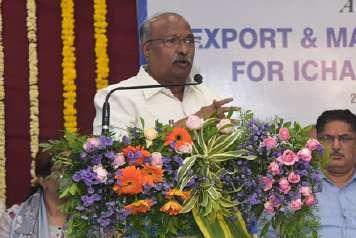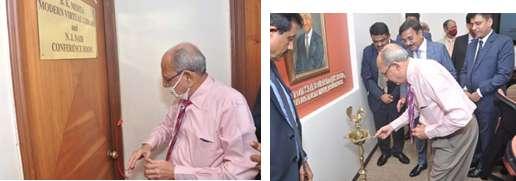
9 minute read
PIVOTAL:Innovative Strategic Relook at Multiple Fibres - Mr. Suresh Kotak
PIVOTAL: INNOVATIVE STRATEGIC RELOOK AT MULTIPLE FIBRES
MR. SURESH KOTAK
Advertisement
Chairman , Kotak Commodities
The reimagining the Global Textile Industry and the opportunities for India is timely and also critical. It is also imperative for us to assess and think in this direction right away. We must get into the state of sufficient and efficient desire for excellence and get our rightful place in the global participation prominently. The government has rightly initiated multi measures from all directions to enable and empower this industry to come up to global standards and become a vital part of International textile chain with pre dominance. The aim is to become alternative supplier to cater to the global requirements in terms of reach out, capacity building and meeting global competition in textiles.
Various measures are in the direction of positive initiations and encouragement - technological upgradation, infrastructure scaling, adding and improvisations. It also addresses the skill deficiencies and emerging environmental cautions, sustainable requirements and adaptation to emerging world after Corona pandemic. The emerging geo political and environmental requirements have been also conducive for changing the dynamics of Indian Textile Industry. Very aptly and appropriately the textile community and the government are thinking harmoniously to give total uplift to the textile industry and make it viable and acquire a significant supplier role of textiles in the global context. The new textile policy is also in the wings. Production Link Incentivization (PLI) Augments Efficient Diversified Textile Products
We have now significant encouragements in various government schemes along with PLI i.e. Production Linked Incentivization. This is cardinal scheme.
One of the most important considerations which is being contemplated is Focused Product Incentive Scheme (under PLI). This would lead to product diversification which is a sine – qua – non to MAP and MATCH the global product requirements. Global product requirements are highly diversified and specific. This step could revolutionize our total textile scenario and will make our textile industry SAMARTH and SAKSHAM to meet the global challenges. The production oriented incentive approach of government is directionally correct.
I believe that efficient supply which gets clearly into diversification of the products in terms with HS Codes deliberations with study of different products globally traded could be immensely transformational. I am also reminded by my relook at economists JB Say’s law “Supply Creates Demand”. This reinforces my view that strengthening supply chain is imperative, keeping in view the demand axis. These measures will address itself to the buyers requirements also. The enhanced production capabilities will satisfy the global requirements. The result for India will be --- that which is being sourced just now only from one country will be alternatively sourced from India also.
My endeavoured niched study in following paragraphs is more oriented towards the Fibre Profile of India in above context. The fibres strength is pivotal for the resurge, reform and reboot of our textile industry. We have to also introspect about our fibre endowments which can really give us very fundamental strength to come up to greater and greater heights. I need not emphasize but the raw materials are very foundational of any industry, not only textiles.
Rich Fibre Endowments of India
The strength of multi fibres that we have today needs optimization and research orientation will enable India to come up with the grips and lead the way to become an alternative textile supplier to world markets. In India’s case we have many strong points about our fibre endowments. You need to appreciate that our good fibre endowments are PIVOTAL and FOREMOST for achieving dynamism in textile industry. In the following paragraphs I would like to invoke some thoughts on our Fibres Endowments and how to invoke an internal rise these strength as growth proponents.
Today, India ranks as the biggest producer of Cotton in the world. It also has the highest acreage devoted to cotton production but sill it has to import certain extra length staple cotton as well as certain extra strength cotton and contamination free cotton regularly. We need to address our self to remove this lacuna as well as other persisting lacunas.
We need to ingest our strength of this biggest and precious most raw material endowment – raw cotton.
Cotton is not only of civilizational or social value but also has immense economic value which is unrealised and not operationalized. It has been researched by Techno Economic Researchers that Cotton has great potential power to resurge our national eco system Metamorphically. Cotton is a multi-component produce and it has elongated utilizable supply chain. This chain extends backward and forward. The economics of this value chain is still underutilized or not sufficiently unfolded. The cotton essentially is a bi-component product. The cotton comes in an unginned form having 2/3rd in form of cotton seed and 1/3rd of raw cotton fibre. Thus, it is a forward and backward supply chain – one of cotton i.e. 33% and 67% of oil bearing cotton seeds. A Cotton seed is a huge oil economy and it enriches cotton eco system. The total cotton seed production averages 10million tonnes of cotton seeds.
We need to appreciate work of CIRCOT in this connection. CIRCOT, is a government organisation established in 1926 and has been relentlessly working in the direction of cotton and other fibre applications in different ways and increase fibre efficiency in applications. it researches in the technology aspects with a view to develop, innovate fibre applications. CIRCOT works for different blends of fibres with cotton and thus developed wide spectrum fibre uses in association with Cotton. tile products for differing textile applications which can kick start many many new textile goods unit, uniqueness of which can give us primacy in international; area.
I recommend everybody concerned with fibre and textiles to become familiar with CIRCOT and benefit. Even cotton residues, plant residues like Stalks have multiple uses as researched by CIRCOT.
The residues in cotton chain like linters or seeds are highly utilizable and can create enormous wealth and value. The latest research is Nano Cellulosic Material of high technical multiple applications out of cotton residues. There is also an attempt by CIRCOT to develop naturally coloured cotton. I am connected with ISCI (Indian Society for Cotton Improvement) and Indian Fibre Society where retired and active scientists of CIRCOT and other fibre institutions work together with industry and farmers to create conditions and cultural promotion for our fibre endowments.
Other Natural Fibres
India has endowment in various other natural fibres such as Bamboo Fibre, Fruit Fibres from Banana and Pineapple. Tree Fibres, like Kapok and Ankund and coconut fibres like Coir and some others. We also have animal fibres like Wool and Silk. Bast Fibres like Jute, etc. kindly refer to the total fibre chart given at the end of fibre discussion to appreciate the rich over all fibre endowments in India with primacy of cotton. All these natural fibres are documented by FAO in a global meeting in 2009, where I attended as Indian Representative and presented our heritage of different fibres. WE NEED TO UTILIZE ALL THIS and develop very competitive applications in development of innovative textile products.
Cellulosic Manmade Fibres.
We have pulpy woods which give us cellulose and we are producing rayon fibres out of that. The ongoing developments are that we can utilize natural residues of Cotton, reutilization of textile fabrics (Lenzing has already done). Mineral Fibres
The most important mineral fibre which is derived from Hydrocarbons is well known Polyester and other associative fibres like Nylon, Poly ethane Acrylic and so on. There is a huge development in this and it has captured as a principal fibre globally. INDIA IS THE SECOND LARGEST PRODUCER OF MANMADE FIBRES with world class organisation like Reliance and Indo Rama, we produce good amount of Polyester Fibre. WE ARE QUITE ADVANCED IN THIS AREA of manmade fibre production we still need to develop many speciality manmade fibre for our technical textiles and industrial applications.
This area of fibre is also our present Strength to give diversified products and production. With all the advantages of having one of the largest base of fibre availability of different kinds, its applications in terms of blend and product innovations and its proper utilization is to be addressed without any delay or hesitancy. We can augment our diversified resource advantage rapidly. The resource advantage that we have, no other country has. Refocus on Cotton as High Priority - Significant most – pivotal material for our textile economics.
With all this I recommend to enhance, use and utilization of Cotton as pivotal fibre which has versatile uses and untapped applications. We need to research and innovate in this area by use of genomics and other instruments of bio technology, etc. It is lamentable that our cotton endowment has still not been taken full advantage of utilization and applications. Indian cotton has the largest area under single crop. It has a great propensity to raise its productivity from 500 to minimum 2000kg per hectare. Actually the highest productivity has been achieved upto 2000kg in Brazil, about 1200kg in China and in Pakistan hovers around 900kgs.
India also has a great advantage in having all the variety Cotton of different counts but still we suffer on account of contamination, adulteration and lower parameters as compared to global cotton for same count, etc. these lacunas should be removed in the right earnest. The cotton as a fibre is always open to greatest degree of achievement and the organic cottons can support bio diversity and biological cycles
Organic Cotton
India can lead in the organic cotton. Today we are producing 59470 metric ton i.e. 51% of global production, china with 22521MT which is 19%, Kirgizstan with 8019MT which is 6.8%, Turkey 7741MT which is 6.6%, Tajikistan with 6405MT which is 5.4%, USA with 4%, Tanzania with 3%.
Organic farming in India is certified under the NPOP i.e. National Program for Organic Production. There are 200 producer goods in 8 states. The total area under organic cultivation is 1, 72,180 hectare. Let us realise that cotton has much greater economics than presently seen. It is not only a fibre crop but also an oil producing crop. And each part of cotton is commercially usable with great utility and applications. What an enormous amount of textile opportunities we can create out of cotton – our richest fibre endowment, we still have to visualise comprehensively, directionally and strategically.
Conclusion
The last world trade organisation’s economic conference in Davos in 2018 has defined the coming times of economic change as setting of fourth industrial revolution.
We have to realise that we have entered the era of circular economy (reference Davos 2018 McKenzie) the sustainability and regenerative abilities of natural fibres will play a great part and due to environment demand is more of organic natural fibres. Here cotton is already
Total Fibre Chart – could be available in India
well entranced in fabric of Indian economy can play pivotal dominant role. We need to appreciate that the fibres of synthetic origin requires enormous level of energy and are manufactured by different processes producing varying levels of greenhouse gas omission. The global consumers are increasingly becoming concerned about the environmental impact on their lifestyle and consumption pattern and are willing to pay premium for textiles of organic material.
It has been recommended that carbon based products obtained by synthesising chemical or petroleum products needs to be discouraged and go for more of reuse of that material.
However, we should still utilize all the fibres judiciously, aptly and with discriminations and lead the spectrum of fibre availability to invigorate our new era for radicalization of our textile power.










